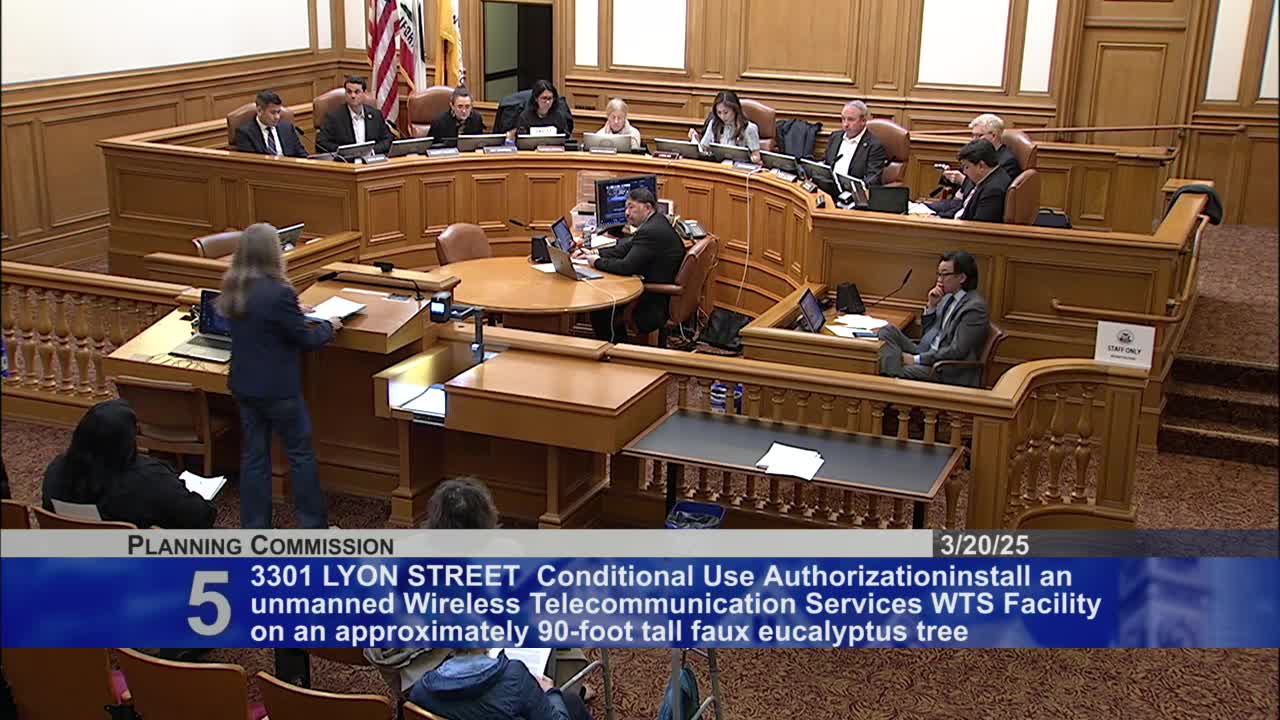City Commission reviews AT&T's faux eucalyptus tree plan near Palace of Fine Arts
March 20, 2025 | San Francisco City, San Francisco County, California
This article was created by AI summarizing key points discussed. AI makes mistakes, so for full details and context, please refer to the video of the full meeting. Please report any errors so we can fix them. Report an error »

In the heart of San Francisco, a significant discussion unfolded at a recent city commission meeting, focusing on a project that has been a decade in the making. As city planners and project sponsors gathered, the spotlight was on the proposed installation of a new communication monopole near the iconic Palace of Fine Arts, an area notorious for its high rate of car break-ins and poor cell service.
City planner Cammie Woods opened the meeting by emphasizing the necessity of enhancing communication services, particularly for first responders. “We have been working hard to find a good spot for it,” she stated, clarifying that the proposed structure would not overshadow the historic dome but would instead be a discreet monopole located in the parking lot. This decision aims to improve connectivity not only for emergency services but also for the surrounding neighborhoods that currently experience significant dead zones for cell service.
Eric Lentz, representing AT&T, echoed these sentiments, detailing the extensive efforts made over the past ten years to find an appropriate location that balances public needs with recreational uses in the area. He highlighted the importance of reliable communication services, especially in a region frequented by both locals and tourists.
As the discussion progressed, concerns were raised about the visual impact of the monopole. Commissioner Moore sought clarity on the visual simulations provided, questioning the accuracy of representations that included existing trees. “Is there any new visualization that we could perhaps see?” he asked, expressing a desire for a clearer understanding of how the structure would blend into the landscape.
In response, project representatives explained that the proposed faux eucalyptus tree design was chosen for its aesthetic compatibility with the area. Unlike traditional monopoles, the faux tree would mimic the surrounding eucalyptus trees, providing a more natural appearance. They assured the commission that the design would not only meet functional needs but also respect the visual integrity of the historic site.
As public comment was invited, the room remained silent, indicating a lack of opposition from community members. With no further comments, the commission moved to deliberate on the project, which promises to enhance both safety and connectivity in a beloved San Francisco landmark.
This meeting marks a pivotal step towards improving communication infrastructure in the city, reflecting a commitment to both public safety and the preservation of San Francisco's unique character. As the project moves forward, residents and visitors alike may soon benefit from enhanced connectivity, ensuring that the Palace of Fine Arts remains not only a cultural treasure but also a well-connected hub for all.
City planner Cammie Woods opened the meeting by emphasizing the necessity of enhancing communication services, particularly for first responders. “We have been working hard to find a good spot for it,” she stated, clarifying that the proposed structure would not overshadow the historic dome but would instead be a discreet monopole located in the parking lot. This decision aims to improve connectivity not only for emergency services but also for the surrounding neighborhoods that currently experience significant dead zones for cell service.
Eric Lentz, representing AT&T, echoed these sentiments, detailing the extensive efforts made over the past ten years to find an appropriate location that balances public needs with recreational uses in the area. He highlighted the importance of reliable communication services, especially in a region frequented by both locals and tourists.
As the discussion progressed, concerns were raised about the visual impact of the monopole. Commissioner Moore sought clarity on the visual simulations provided, questioning the accuracy of representations that included existing trees. “Is there any new visualization that we could perhaps see?” he asked, expressing a desire for a clearer understanding of how the structure would blend into the landscape.
In response, project representatives explained that the proposed faux eucalyptus tree design was chosen for its aesthetic compatibility with the area. Unlike traditional monopoles, the faux tree would mimic the surrounding eucalyptus trees, providing a more natural appearance. They assured the commission that the design would not only meet functional needs but also respect the visual integrity of the historic site.
As public comment was invited, the room remained silent, indicating a lack of opposition from community members. With no further comments, the commission moved to deliberate on the project, which promises to enhance both safety and connectivity in a beloved San Francisco landmark.
This meeting marks a pivotal step towards improving communication infrastructure in the city, reflecting a commitment to both public safety and the preservation of San Francisco's unique character. As the project moves forward, residents and visitors alike may soon benefit from enhanced connectivity, ensuring that the Palace of Fine Arts remains not only a cultural treasure but also a well-connected hub for all.
View full meeting
This article is based on a recent meeting—watch the full video and explore the complete transcript for deeper insights into the discussion.
View full meeting
